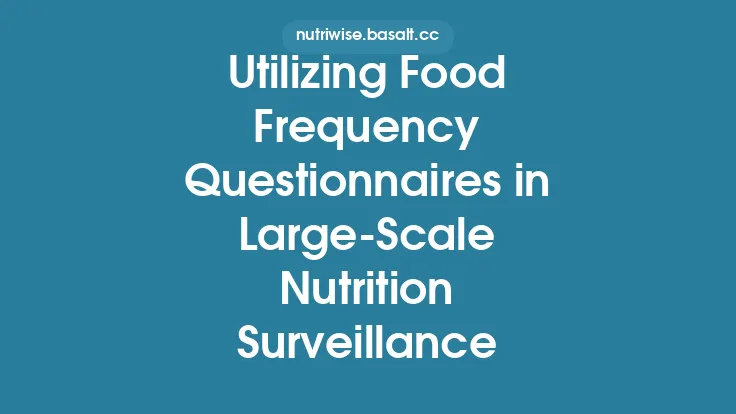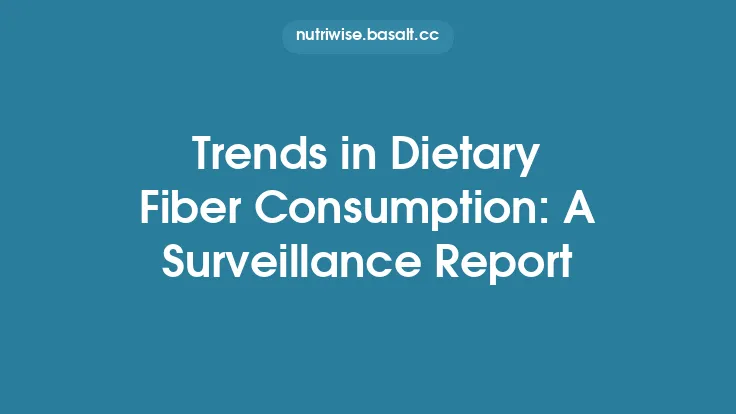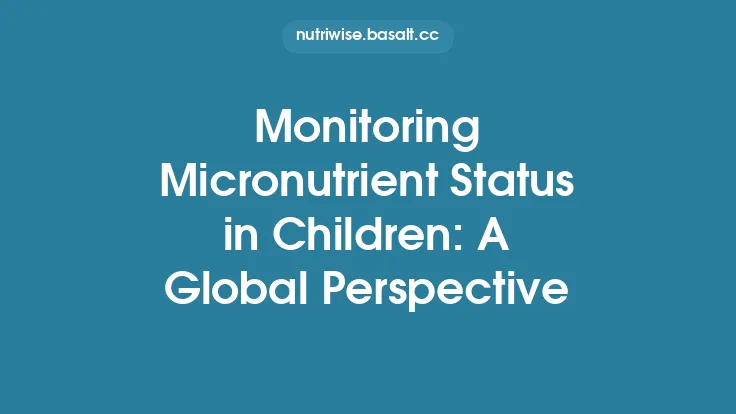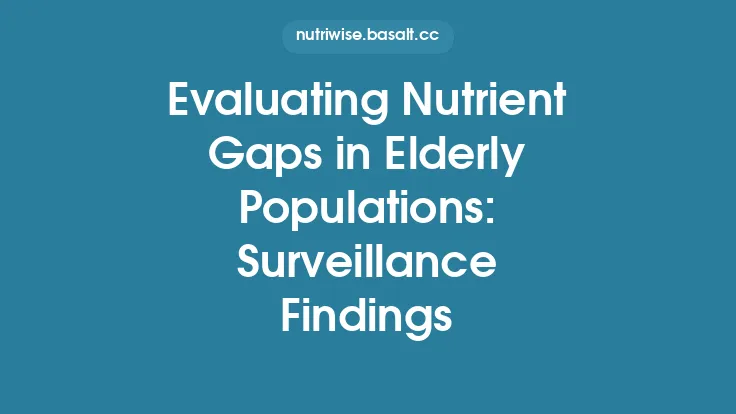Regional disparities in nutrient intake remain a pivotal concern for public health officials, policymakers, and researchers worldwide. While national averages can suggest overall adequacy or deficiency, they often mask substantial variations between geographic areas, socioeconomic groups, and cultural contexts. Understanding these differences requires robust surveillance systems that can capture granular data, apply sophisticated analytical techniques, and translate findings into actionable interventions. This overview synthesizes the core components of regional nutrient‑intake surveillance, outlines methodological best practices, highlights illustrative case studies, and discusses emerging opportunities for strengthening the evidence base.
1. Foundations of Regional Nutrition Surveillance
1.1 Defining “Region” in Nutrient Monitoring
The term *region* can refer to administrative units (states, provinces, districts), ecological zones (coastal vs. inland), or culturally defined areas (ethnic enclaves). Selecting an appropriate spatial scale is critical because it influences sample size requirements, data collection logistics, and the relevance of findings for local decision‑makers. Multi‑level frameworks that allow aggregation from fine‑grained (e.g., census tracts) to broader (e.g., national) levels enable analysts to explore both micro‑ and macro‑patterns.
1.2 Core Surveillance Objectives
- Identify geographic hotspots of nutrient deficiency or excess.
- Track temporal trends within regions to detect emerging problems.
- Assess the impact of regional policies, food environments, and market dynamics on intake.
- Provide evidence for targeted nutrition programs and resource allocation.
1.3 Data Sources Commonly Integrated
| Source | Typical Content | Strengths | Limitations |
|---|---|---|---|
| Household Consumption and Expenditure Surveys (HCES) | Food acquisition, expenditures, occasional 24‑h recall | Large, representative, captures food availability | Limited detail on individual intake, recall bias |
| Sentinel Health Examination Surveys | Biomarkers, anthropometry, dietary recalls | Objective nutrient status, clinical relevance | Expensive, less frequent |
| Retail and Market Scanner Data | Sales volumes, price trends | Real‑time market dynamics, high granularity | Does not reflect actual consumption, may miss informal markets |
| Community Food Environment Audits | Store types, food pricing, accessibility | Direct link to food access | Labor‑intensive, snapshot in time |
| Mobile Dietary Assessment Apps | Real‑time self‑reported intake, geotagging | High temporal resolution, user engagement | Self‑selection bias, data quality concerns |
Combining multiple sources through data linkage or statistical imputation can mitigate individual weaknesses and produce a more comprehensive picture of regional intake.
2. Methodological Approaches for Detecting Disparities
2.1 Sampling Design Tailored to Geography
- Stratified multistage cluster sampling ensures representation across urban/rural, high‑income/low‑income, and culturally distinct zones.
- Oversampling of historically underserved or high‑risk regions improves precision for disparity estimates.
- Probability proportional to size (PPS) sampling aligns sample allocation with population distribution, reducing variance in sparsely populated areas.
2.2 Dietary Assessment Instruments
While food frequency questionnaires (FFQs) are common, they are excluded from the scope of neighboring articles; however, they remain a viable tool when calibrated against 24‑hour recalls or biomarkers. For regional surveillance, multiple-pass 24‑hour recalls administered on non‑consecutive days are preferred for capturing day‑to‑day variability. When resources are constrained, short dietary screeners validated for specific nutrients (e.g., iron, calcium) can be deployed, provided they are regionally adapted.
2.3 Statistical Modeling of Spatial Variation
- Geostatistical kriging interpolates nutrient intake values across unsampled locations, generating continuous surface maps.
- Bayesian hierarchical models incorporate random effects for regions, allowing borrowing of strength across neighboring areas while accounting for measurement error.
- Small‑area estimation (SAE) techniques, such as empirical best linear unbiased prediction (EBLUP), combine survey data with auxiliary information (e.g., census demographics) to produce reliable estimates for small jurisdictions.
- Spatial autocorrelation metrics (Moran’s I, Geary’s C) test whether observed patterns are clustered, dispersed, or random, informing the need for spatially explicit interventions.
2.4 Adjusting for Confounders and Effect Modifiers
Regional intake differences often reflect underlying socioeconomic status, education, cultural food practices, and food system characteristics. Multivariate regression models should therefore include covariates such as household income, parental education, urbanization level, and market access indices. Interaction terms can reveal whether the impact of a policy (e.g., fortification mandate) varies by region.
3. Illustrative Case Studies
3.1 Iron Intake Disparities in a Multi‑Ethnic Federation
A national health examination survey incorporated 24‑hour recalls and serum ferritin measurements across 12 provinces. Bayesian spatial models identified three contiguous provinces in the mountainous north with significantly lower mean iron intake (≈8 mg/day) and higher prevalence of iron deficiency anemia compared with the coastal south (≈13 mg/day). The disparity correlated with limited availability of iron‑rich animal source foods and higher reliance on cereal‑based diets. Targeted interventions—such as community‑based iron‑fortified flour distribution and nutrition education in local languages—were piloted, resulting in a 15 % reduction in anemia prevalence after two years.
3.2 Regional Variation in Sodium‑Containing Processed Foods
Retail scanner data linked to household purchase surveys revealed that urban districts in the capital region purchased processed foods with an average sodium density of 1.2 g/100 g, whereas rural districts in the same country averaged 0.7 g/100 g. Spatial regression indicated that proximity to large food manufacturing hubs and higher median household income were strong predictors of sodium‑dense product consumption. Policy implications included the need for region‑specific front‑of‑package labeling and reformulation incentives for manufacturers serving high‑sodium markets.
3.3 Vitamin A Intake Gaps in Semi‑Arid Zones
Using a combination of HCES data and biomarker surveys, researchers mapped vitamin A intake across agro‑ecological zones. Semi‑arid zones displayed the lowest intake (≈400 µg RAE/day) and highest prevalence of subclinical deficiency. The analysis highlighted limited production of vitamin A‑rich fruits and vegetables due to water scarcity. As a response, a regional agricultural extension program introduced drought‑tolerant orange‑fleshed sweet potato varieties, leading to a measurable increase in household vitamin A intake within three growing seasons.
4. Translating Surveillance Findings into Policy
4.1 Evidence‑Based Targeting
- Resource Allocation: Funding for nutrition programs can be prioritized for regions identified as high‑risk, ensuring cost‑effectiveness.
- Regulatory Actions: Regional disparities in processed‑food nutrient profiles may justify localized labeling requirements or reformulation targets.
- Food System Interventions: Mapping of food deserts and nutrient‑poor retail environments informs incentives for grocery store placement, mobile markets, or community gardens.
4.2 Stakeholder Engagement
Effective translation requires collaboration among ministries of health, agriculture, trade, and education, as well as local NGOs and community leaders. Dissemination tools such as interactive GIS dashboards, policy briefs tailored to regional decision‑makers, and community workshops enhance uptake of surveillance insights.
4.3 Monitoring Impact of Interventions
Post‑implementation surveillance cycles should incorporate process indicators (e.g., fortification compliance rates) and outcome indicators (e.g., changes in regional nutrient intake). Time‑series analyses can detect whether observed improvements are sustained or if new disparities emerge.
5. Challenges and Limitations
| Challenge | Description | Mitigation Strategies |
|---|---|---|
| Data Incompatibility | Different surveys use varying food composition tables, units, or recall periods. | Standardize data processing pipelines; adopt a unified national food composition database. |
| Sparse Data in Remote Areas | Low population density leads to high sampling variance. | Apply small‑area estimation; integrate remote sensing data (e.g., land‑cover for agricultural production). |
| Cultural Sensitivity | Dietary patterns are deeply rooted in tradition; surveys may miss culturally specific foods. | Conduct formative qualitative research; involve local experts in questionnaire design. |
| Rapid Food System Changes | Introduction of novel processed foods can outpace data collection cycles. | Incorporate real‑time market scanner data; use mobile app–based dietary reporting for rapid updates. |
| Resource Constraints | Comprehensive surveillance is costly and labor‑intensive. | Leverage existing administrative data; employ mixed‑methods designs that combine high‑frequency low‑cost data with periodic in‑depth surveys. |
6. Future Directions
6.1 Integration of Big Data and Machine Learning
- Digital Purchase Records: Linking loyalty‑card data with geolocation can provide near‑real‑time insights into regional consumption trends.
- Satellite‑Derived Food Production Estimates: Machine‑learning models can predict regional availability of key nutrient‑dense crops, complementing household surveys.
- Predictive Analytics: Ensemble models that combine socioeconomic, environmental, and market variables can forecast emerging nutrient gaps before they manifest in health outcomes.
6.2 Strengthening Community‑Based Surveillance
Participatory monitoring, where community health workers collect simplified dietary data using mobile tools, can fill gaps in hard‑to‑reach areas and foster local ownership of nutrition initiatives.
6.3 Harmonization Across Borders
Transnational regions (e.g., river basins, cultural zones) often share food systems. Developing standardized surveillance protocols across neighboring countries enables comparative analyses and coordinated policy responses.
6.4 Linking Nutrient Intake to Health Outcomes at the Regional Level
While many surveillance systems capture intake alone, integrating electronic health records and disease registries can elucidate the direct impact of regional nutrient disparities on conditions such as anemia, hypertension, or osteoporosis, thereby strengthening the evidence base for targeted interventions.
7. Concluding Remarks
Regional disparities in nutrient intake are a persistent and complex public health challenge. Robust surveillance—grounded in sound sampling, precise dietary assessment, and advanced spatial analytics—provides the essential evidence needed to uncover hidden inequities, guide targeted policies, and monitor the effectiveness of interventions. By embracing methodological innovations, fostering cross‑sector collaboration, and ensuring that data are translated into actionable strategies, nutrition surveillance can move beyond description to become a catalyst for equitable improvements in dietary health across all regions.





